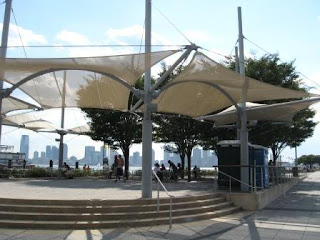Today I rode into Manhattan for a couple of errands and to have lunch with Bruce. Even though I rode my "beater" (the Le Tour), I decided take a bit of a ramble around the city.
Somewhere along the way, it seems, a hipster couldn't bear giving up his bike when he got married and had a kid:
This Peugeot "Nice" was parked across the street from where the World Trade Center once stood. I've seen bikes like it--which may also have been Nices--in France and Montreal. But this is the first time I've seen one here in New York.
To be fair to hipsters, that paint job is pure '80's.
Aside: I didn't go anywhere near the WTC for a couple of years after 11 September. Although I didn't lose anyone I knew, I simply couldn't bear to be around it.
I continued down Broadway to the ferry terminals. I missed the day's last ferry to Governor's Island and I decided I didn't really want to take the ferry ride to Staten Island, as much as I enjoy it.
Another aside: Staten Island is at its closest to the rest of New York at the Verrazano Narrows, where the eponymous bridge crosses it. At that point, SI is about 4300 feet from New York. However, the island is only 600 feet away from New Jersey. After the English took New York and New Jersey from the Dutch (who took it from the Lenape Indians), they supposedly settled the dispute over whether Staten Island belonged to New York or New Jersey with a boat race:
Was anyone accused of doping? Maybe they can use the Tour de France to decide whether France or Spain gets Andorra.
Anyway, I rode up the Greenway that skirts the Hudson. Lots of the cyclists I saw today probably moved to New York in the last few years. They don't remember the city without the Greenway. They also probably think the Christopher Street Pier always looked something like this:
I remember when it looked nothing like that. My earliest memories were more like what you see in this photo Ross Lewis took in 1993:
Believe it or not, I actually ventured out onto the pier when it was something like that. My first adventure there was during my high school years, in the mid-1970's. I don't remember much about it because, well, I did something teenagers sometimes do when they're someplace they're not supposed to be. I don't think I would've gone onto that pier if I weren't intoxicated. In fact, I probably wouldn't have crossed under the elevated West Side Highway. A truck crashed through it in the early 1970's; although it was closed immediately, it wouldn't be demolished for another 15 years. In the meantime, only those who were intoxicated, adventurous or simply had noplace else to go would cross under that highway to get to piers that were, in some cases, literally falling into the water.
For a long time, those derelict quais were among the few places to which the public had access on New York City's hundreds of miles of shoreline. New York is different, in that sense, from other seaport towns like Boston, San Francisco and Istanbul: Until recently, there was really no individual or civic pride in the waterfront. It seemed as if one's social status was directly proportional to how far one was from the water. That might be the reason why addresses along Fifth Avenue, which is further from the waterfront than any other New York City Avenue, became the most prestigious in the city.
I have long said that New York could be, by far, the most beautiful city in the world if its waterfront were cleaned up. I'm glad to see that's happening, finally. Still, it's almost surreal to see the shorelines become places of recreation.
One of my uncles worked on the Brooklyn docks; as a teenager, my mother worked in a factory just steps away from those docks. When I was a child, my father worked in a factory that was less than a block from the 57th Street pier, which is only about half a mile from the Intrepid. Those workplaces, not to mention those jobs, are long gone. In fact, the old Maritime Union headquarters in Brooklyn, which took up an entire square block, is now Al-Noor, said to be the largest Muslim elementary school in the United States.
I continued up the Greenway past the Boat Basin, Harlem toward the George Washington Bridge
On my way back, I saw this charmingly theatrical facade:
This building was the old Audubon Ballroom. Many jazz performers played there; in addition, the Audubon was a movie theatre and a meeting-place for labor activists. However, it seemed not to recover from having been the site of Malcolm X's assassination until Columbia-Presbyterian Medical Center turned it into a research laboratory during the 1990's.
How much else will change by the time I take another ride like the one I took today?







